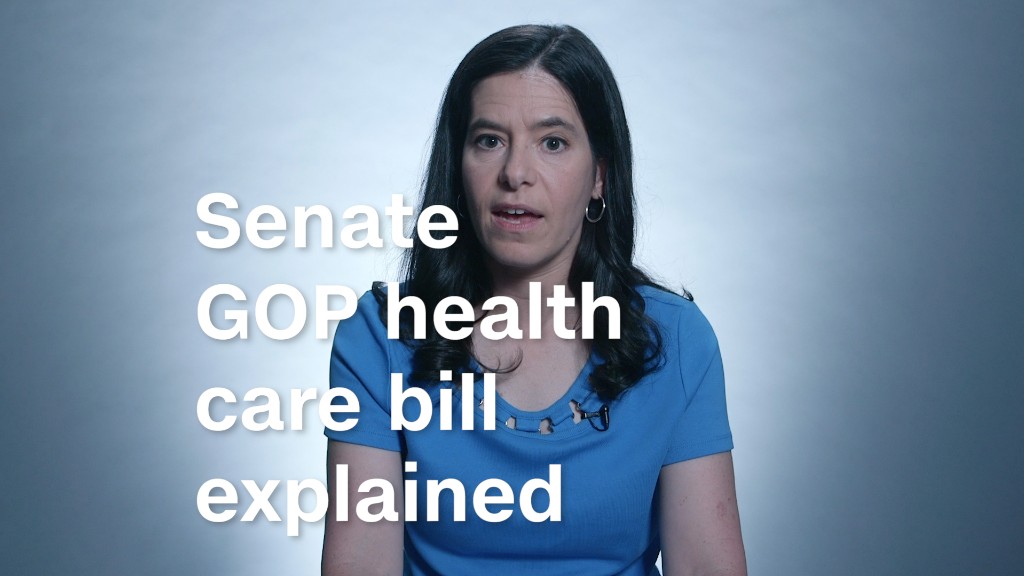
The Senate Republican health care bill would leave 22 million fewer Americans with health insurance by 2026 than under Obamacare, the nonpartisan Congressional Budget Office said Monday.
The highly anticipated score answers key questions about the impact of the Senate's controversial legislation made public last Thursday. The analysis also offers clarity to wavering Senate Republicans on whether to vote for the bill later this week.
The CBO also found the bill would reduce deficits by $321 billion over the next decade.
The House passed its version of an Obamacare repeal bill in May. That legislation would leave 23 million fewer Americans with health insurance by 2026 than under the Affordable Care Act, CBO said earlier.
Senate Majority Leader Mitch McConnell is insisting on a vote this week before lawmakers leave town for the July 4th recess. There are 52 Republican senators, and he needs 50 "yes" votes to move the bill through the Senate. At least five Republicans have so far publicly stated that they cannot support the legislation in its current form.
The largest savings in the Senate bill would come from reducing federal spending on Medicaid, which would decline by 26% by 2026, compared to current law. Like the House plan, the Senate's version would end enhanced funding for Medicaid expansion, though at a slower pace, while overhauling the entire Medicaid program.
Federal spending on Medicaid would be reduced by $772 billion over the next 10 years, compared to current law. Some 15 million fewer Americans would be covered by Medicaid in 2026 -- a deeper cut than under the House bill.
Related: Senate GOP health bill would slash Medicaid. Here's how.
Also, senators would eliminate the mandates that require nearly all Americans to have coverage and companies with more than 50 workers to provide health benefits.
And it would jettison Obamacare's taxes on the wealthy, insurers and others. These provisions, along with some others in the bill, would increase deficits on net by $541 billion, the CBO found. The costliest among them: The repeal of the 3.8% net investment tax on rich Americans, which would reduce revenue by $172.2 billion.
However, the Senate bill would maintain much of Obamacare's subsidy structure to help people pay for individual coverage, but make it less generous, particularly for older enrollees. The federal government would spend $424 billion less on these subsidies under the Senate bill, compared to under Obamacare.
And senators would keep more of Obamacare's insurance regulations than the House legislation, while allowing insurers to charge more to older policyholders.
The Senate version also provides funds to stabilize the Obamacare market over the next few years, including money for a key set of subsidies for insurers.
CBO found that premiums would likely rise next year and the year after under the Senate bill, but would fall after that. In 2020, the average premium for the benchmark plan would be about 30% lower than under current law, mainly because those policies would cover fewer benefits -- and come with much higher deductibles -- and because insurers would receive federal funds designed to lower rates.
By 2026, average premiums would be about 20% lower. The decrease would be less than in 2020 mainly because of a reduction in the federal stabilization funding.
Related: CBO report puts health care bill in jeopardy
Older and lower-income enrollees would be hit harder by the GOP plan, the CBO analysis found. A 64-year-old with an income of $56,800 would pay $6,800 for a silver plan under current law. But that consumer would pay $20,500 for such a plan under the Senate bill.
A person making $26,500 would pay more for coverage under the Senate law at ages 21, 40 and 64.
Who would pay less? A 21-year-old and a 40-year-old earning $56,800 a year.
Also, CBO found that those with annual incomes below the poverty line in states that didn't expand Medicaid would get hefty subsidies under the Senate plan, unlike in Obamacare. They would only have to pay a few hundred dollars a year for coverage. However, experts say it would be unlikely that these folks would buy coverage since the deductibles would be thousands of dollars a year.
Overall, enrollees in the individual market would have to pay a lot more for health care services, particularly in states that seek waivers from Obamacare's insurance regulations. The federal subsidies would be pegged to plans that only pick up 58% of costs, on average, roughly comparable to an Obamacare bronze plan. This year, bronze plans have deductibles of about $6,000.
But Obamacare's subsidies are tied to silver plans, which cover about 70% of costs and have deductibles of about $3,600 this year.
Related: The truth about the uninsured rate in America
The individual market would be stable in most areas of the country under the Senate plan, the CBO projected. The legislation's premium subsidies and stabilization funds would help keep rates low enough to attract healthy enrollees.
In analyzing the House bill, the CBO estimated that the market would be stable under current law, but could break down in states that seek extensive waivers from Obamacare rules.
An estimated total of 49 million people would be uninsured in 2026 under the Senate bill, compared with about 28 million who would lack coverage under current law. This would reverse years of coverage gains under Obamacare.
CNNMoney Senior Writer Jeanne Sahadi contributed to this report.


